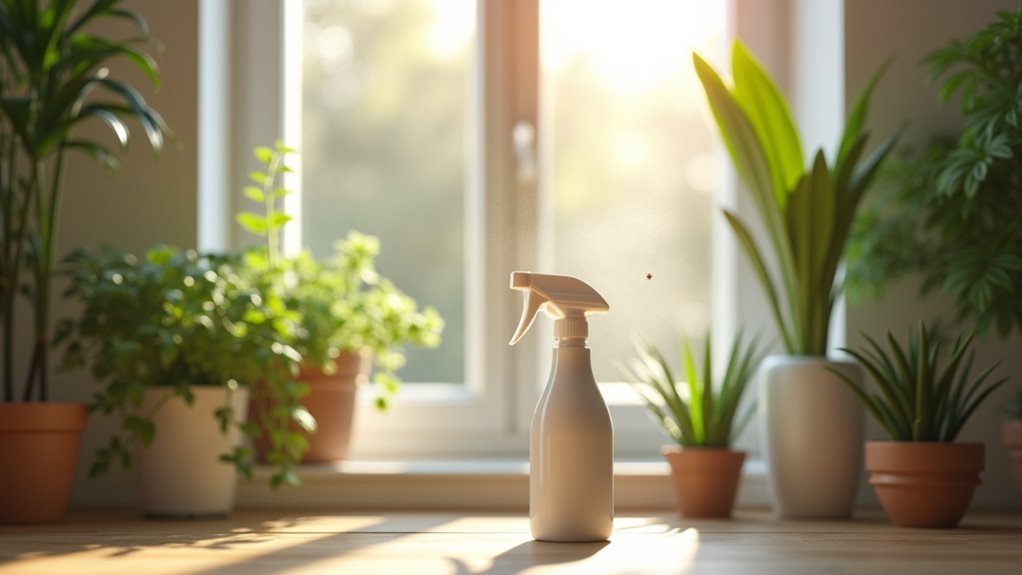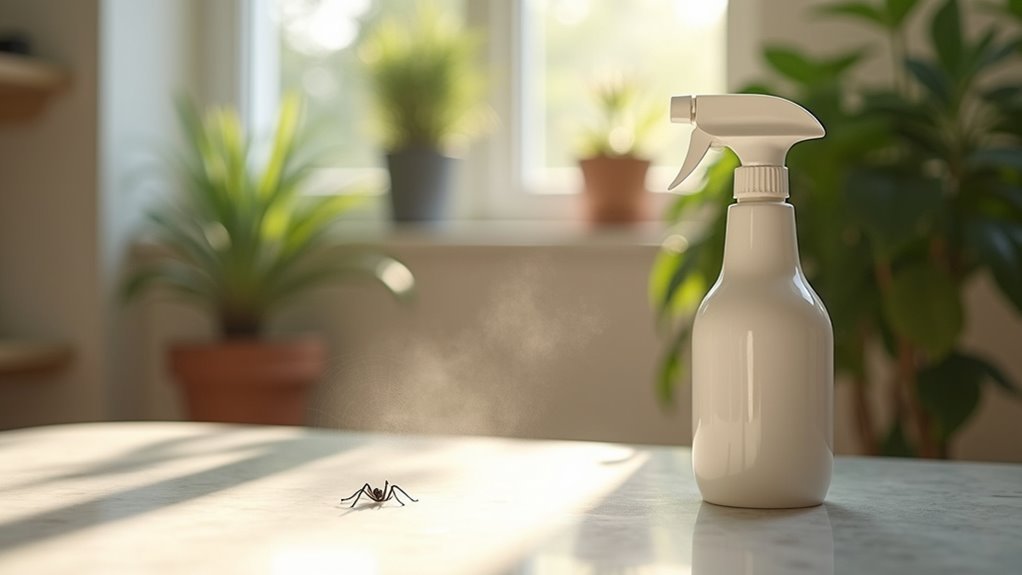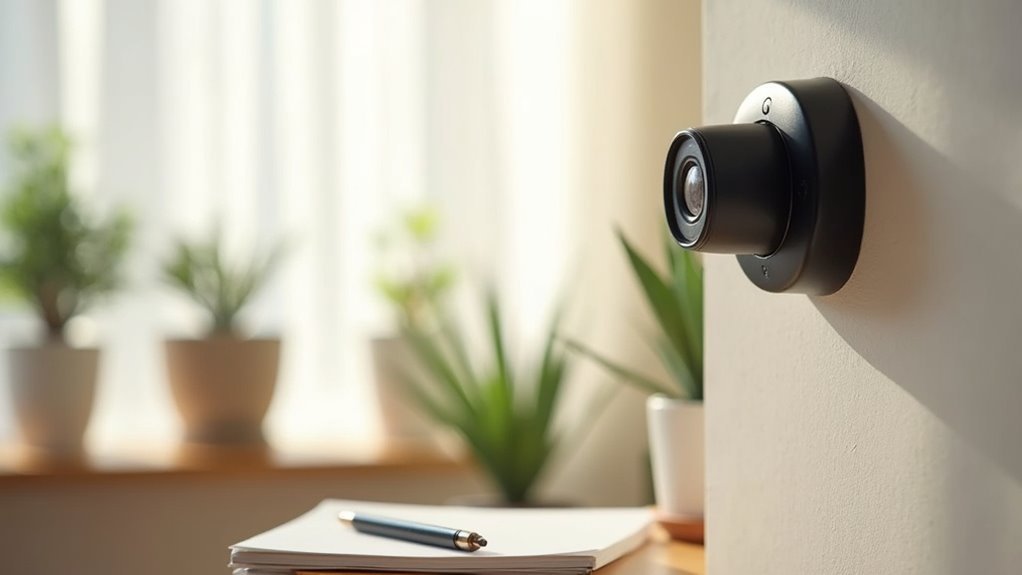You can create an effective spider repellent spray by mixing 2 cups of distilled white vinegar, 1/4 cup of liquid soap, and 30 drops of cinnamon essential oil in a 16-ounce spray bottle. Focus on entry points like doors, windows, and cracks, plus dark corners where spiders hide. Apply monthly and combine with regular vacuuming to disrupt their habitats. This affordable solution will transform your apartment into an unwelcoming environment for these eight-legged intruders.
Understanding Spider Behavior in Small Spaces

Since spiders naturally gravitate toward environments that offer both protection and prey, your apartment presents an ideal hunting ground with its numerous hiding spots and steady food supply.
These eight-legged intruders seek dark corners, basements, and cluttered areas where they can establish webs undisturbed. Spiders like to hide in bathrooms and kitchens because high humidity creates perfect conditions for both them and their prey.
High humidity in bathrooms and kitchens creates ideal conditions for spiders to thrive and hunt their prey.
You’ll notice increased spider activity at night since most species are nocturnal hunters. They’ll squeeze through cracks and crevices as small as a dime to access your space.
To prevent spiders from settling in, focus on eliminating household pests that attract them and commit to regular cleaning and decluttering, which destroys potential habitats.
Essential Ingredients for Homemade Spider Spray
When creating an effective homemade spider spray, you’ll need just three powerful ingredients that work together to repel and eliminate these unwanted invaders.
Start with 2 cups of distilled white vinegar, which serves as your primary repellent while disrupting spider egg cycles.
Add 1/4 cup of liquid soap—castile or dish soap works perfectly—to help the solution stick to spiders and break down their protective outer layer.
Finally, incorporate 30 drops of cinnamon essential oil, one of the most potent natural spider repellents available.
These essential oils enhance the spray’s effectiveness for both killing and repelling spiders.
This simple combination creates 16 ounces of cost-effective spider control solution that targets multiple aspects of spider behavior.
Step-by-Step Spray Preparation Process

You’ll need to gather your essential ingredients before mixing your spider repellent spray.
Once you’ve collected everything, you’ll combine the components in the correct proportions to create an effective solution.
Finally, you’ll learn the proper techniques to apply this homemade spray throughout your apartment for maximum spider control.
Gather Essential Spray Ingredients
Before mixing your spider repellent spray, you’ll need to collect four essential ingredients that work together to create an effective deterrent.
To gather essential spray ingredients for your homemade spider spray, start with a 16-ounce glass spray bottle as your container.
You’ll need approximately 2 cups of distilled white vinegar, which serves as the primary base and kills spiders on contact.
Add 1/4 cup of liquid soap—castile, hand, or dish soap works perfectly—to act as a surfactant that helps the solution stick to surfaces and spiders.
Finally, include 30 drops of cinnamon essential oil for its natural spider-repelling properties.
These four components create a powerful, non-toxic solution that effectively deters spiders from your apartment spaces.
Mix Components Together
Pour 1/4 cup of liquid soap directly into your 16-ounce glass spray bottle, creating the foundation for your spider deterrent mixture.
Fill your spray bottle with water by adding approximately 2 cups of distilled white vinegar up to the neck, being careful not to overflow.
When you mix components together effectively, you’ll create a powerful solution to repel spiders:
- Add 30 drops of cinnamon essential oil (or substitute peppermint oil for similar effectiveness)
- Secure the spray nozzle tightly to prevent leaks during preparation
- Shake vigorously for 20 seconds to guarantee proper ingredient distribution
- Test spray function before applying to targeted areas
This vinegar and water base combines with essential oils to create an effective spider repellent that’s safe for household use.
Proper Application Techniques
The preparation process requires careful attention to ingredient order and mixing techniques to maximize your spider repellent’s potency.
Start by adding liquid soap to your 16-ounce spray bottle first, guaranteeing it settles at the bottom. Next, pour distilled white vinegar up to the bottle’s neck, leaving space for essential oil.
Add exactly 30 drops of cinnamon essential oil to complete your Best Natural Spider repellent formula.
Professional advice emphasizes securing the nozzle tightly before shaking vigorously for 20 seconds to thoroughly combine ingredients. This proper mixing sequence prevents separation and guarantees consistent effectiveness when getting rid of spiders.
Your homemade solution will effectively deter spiders and help eliminate spiders from your home.
Target Areas for Maximum Effectiveness

You’ll get the best results by focusing your spray application on three critical zones where spiders are most active.
Target entry points like windows and doors, high-traffic areas such as corners and baseboards, and prime web formation zones including dark spaces behind furniture.
Strategic placement in these areas creates an effective barrier that prevents spiders from establishing territory in your apartment.
Spider Entry Points
While spiders can squeeze through surprisingly small openings, targeting their most common entry points with repellent spray will dramatically boost your apartment’s defense system.
You’ll want to inspect and seal these vulnerable areas while applying your spider deterrent to keep spiders from gaining access to the exterior of your home.
Focus your repellent application on these critical entry points to keep spiders outside where they belong:
- Doors and windows – Spray around frames, sills, and weatherstripping where gaps commonly form
- Foundation cracks – Target any visible crevices or openings near your apartment’s base
- Utility penetrations – Treat areas around pipes, electrical wires, and ventilation systems
- Screen damage – Apply repellent near torn or loose screening materials
High Traffic Areas
Most spiders gravitate toward specific zones in your apartment where they’re likely to encounter prey and establish territories. High traffic areas like entryways, living rooms, and kitchens are prime hunting grounds for spiders, making them essential targets for your spider repellent spray application.
Focus your efforts on door frames, window sills, and corners where spiders typically build webs. These locations create a protective barrier that prevents entry before spiders establish themselves indoors.
Don’t overlook darker spaces like basements and garages, which attract spiders seeking shelter.
Apply repellent behind furniture and appliances where spiders hide undetected. Reapply your spray every few days in these high traffic areas to maintain effectiveness and prevent spiders from returning to their preferred territories.
Web Formation Zones
Understanding where spiders construct their webs gives you a strategic advantage in preventing infestations throughout your apartment.
You’ll find spider web construction occurs predictably in specific locations where spiders feel secure and can catch prey effectively.
Focus your repellent application on these prime web formation zones:
- Corners – Wall intersections provide structural support and protection for web construction
- High-traffic areas – Doorways and windowsills attract insects, making them spider magnets
- Hidden spaces – Behind furniture, under beds, and inside closets offer undisturbed environments
- Dark storage areas – Attics, basements, and utility rooms create ideal conditions for web building
Application Techniques for Apartment Living
Since apartment living presents unique challenges for pest control, you’ll need to focus your spider repellent spray application on specific high-priority areas where spiders typically enter and establish themselves. Apply the spray along baseboards, in corners, and near entry points like doors and windows to create an effective barrier against indoor spider invasion.
| Location | Application Focus |
|---|---|
| Interior Areas | Corners, baseboards, door frames |
| Entry Points | Windows, doorways, balcony access |
| Outdoor Spaces | Patios, entryways (avoid sensitive plants) |
Reapply your spider repellent every few days, especially after cleaning high-traffic areas. Confirm children and pets aren’t present during application to prevent cinnamon oil irritation. Combine spray treatments with regular cleaning and decluttering for maximum effectiveness in your apartment.
Natural Alternatives to Chemical Repellents
While chemical spider repellents prove effective, natural alternatives offer apartment dwellers safer options that won’t compromise indoor air quality or pose risks to children and pets.
These eco-friendly solutions provide reliable spider control without harsh chemicals.
Peppermint oil mixed with water creates an effective spray for hiding spots. The strong scent naturally deters spiders while leaving your apartment smelling fresh.
Diatomaceous earth works by dehydrating spiders upon contact, making it perfect for sprinkling in problem areas.
Popular natural spider control methods include:
- Vinegar-based cleaning sprays with dish soap and thyme oil that prevent web formation
- Strategic placement of chestnuts in attics and basements to repel spiders
- Indoor plants like basil, mint, and lavender that create scent barriers
- Regular application of peppermint oil solutions around entry points
Maintaining Your Spider-Free Environment
Once you’ve established effective spider control measures, consistent maintenance becomes the cornerstone of long-term success in keeping your apartment spider-free.
Regular vacuuming eliminates webs and disrupts spider habitats in corners and baseboards. Reapply spider repellent sprays or essential oils monthly around entry points to maintain their effectiveness. Inspect and reseal any new cracks or gaps that could invite spiders back into your home.
Monitor your apartment weekly for signs of spider activity. If you notice persistent issues despite your efforts, don’t hesitate to contact professional pest control services for advanced solutions.
Additionally, maintain open communication with your landlord about ongoing prevention efforts. They can assist with sealing structural entry points and coordinating building-wide pest management to prevent spiders from migrating between units, ensuring your maintenance efforts remain effective long-term.
Frequently Asked Questions
What Is the Best Spider Repellent for Apartments?
You’ll find peppermint oil, vinegar, and cinnamon essential oil work best as natural spider repellents. Mix distilled white vinegar with liquid soap and cinnamon oil for an effective DIY spray that’s safe for apartments.
How Do I Keep My Apartment Spiders Free?
You’ll keep spiders away by regularly vacuuming corners, sealing cracks with caulk, maintaining low humidity, using vinegar-based repellent sprays, and placing basil or mint plants around your apartment.
How Do You Make Homemade Spray to Keep Spiders Away?
You’ll mix 2 cups distilled white vinegar, 1/4 cup liquid soap, and 30 drops cinnamon essential oil in a 16-ounce glass bottle. Shake well and spray in corners, windows, and doorways every few days.
How Often Do You Have to Spray Peppermint Oil to Keep Spiders Away?
You’ll need to spray peppermint oil every 3-5 days to maintain its spider-repelling effectiveness. The scent weakens over time, so consistent reapplication guarantees you’re keeping that protective barrier strong around entry points.
In Summary
You’ve now got everything you need to keep spiders out of your apartment naturally. Stick to your regular spraying schedule, don’t skip those hard-to-reach corners, and remember that consistency’s key. If you notice any eight-legged visitors sneaking back in, just increase your application frequency. With these simple techniques, you’ll maintain a spider-free home without harsh chemicals or expensive pest control services.





Leave a Reply